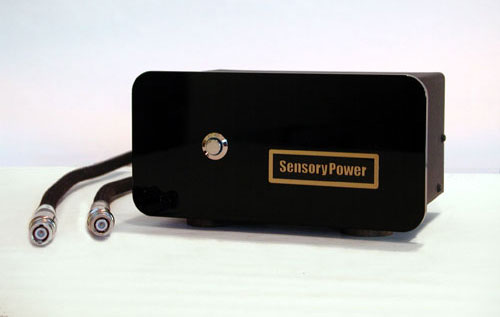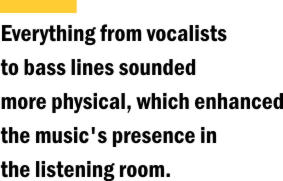SensoryPower • Active Digital Cable
t wasn't until their second decade in existence that CDs started to display sound quality that easily impressed the audiophile crowd. This didn't happen because of some new recording technique or production method. Rather, it was due to the refinement of digital hardware and especially the advent of the separate digital-to-analog converter and CD transport. These split the primary functions needed for playing CDs into independent chassis, giving those who designed the products the freedom -- and often the mandate -- to improve circuits and the sound of digital playback along with it.
But a problem was soon identified. Jitter -- timing errors, often caused by the interface between the DAC and transport -- hurt sound quality and became the most heinous word in all of high-end audio. A number of manufacturers addressed the J-word with separate components that reclocked or buffered digital data before they were sent to the DAC, and these products were generally effective, although some (the Genesis Digital Lens in particular) were more capable than others. Since the middle 1990s, digital components have slowly integrated once again, and the single-chassis CD player now dominates the market. This was made possible by the knowledge gained from pushing the sonic envelope with separates. If you peer inside an Esoteric CD/SACD player, for instance, you will see a chassis that's absolutely packed with circuit boards. Ironically, Esoteric is one of the few companies that still pushes the separates approach, and it includes a dedicated master-clock unit in its product line. All of this background brings me finally to the SensoryPower Active Digital Cable. It is a thoroughly modern spin on an old idea, and it does what it does with great success. Calling it a mere digital cable is a bit of an understatement. While the Active Digital Cable does connect a DAC and transport, providing a pathway for the digital data, it goes far beyond its wire-only competition, addressing jitter in a way that leads to clearly improved sound. Fred Nadel, head of SensoryPower, initially contacted me about listening to his cable with the Zanden Model 5000S DAC and Model 2000P transport, which is one of the very best CD-playing front-ends extant and my personal favorite. Fred is a Zanden dealer as well as the US distributor for BAlabo electronics. I was interested in testing his claim that the Active Digital Cable surpasses the I2S connection scheme Zanden touts. The advantage of I2S is that instead of the word clock being embedded within the digital data sent along the S/PDIF or AES/EBU output-input scheme, it is carried on a separate conductor, so the DAC doesn't have to recover it from the datastream. It is with the word clock that jitter begins to be audible in deleterious ways. Fred recognizes the technical advantage of I2S, but he also has his own spin: "We firmly believe that a superbly executed S/PDIF interface such as we have created with the Active Digital Cable will handily outperform any I2S that is not executed to the same high standards of excellence -- a very small number indeed!" Products that have I2S capability are not abundant, and most (from Audio Alchemy, Camelot, Muse and Sonic Frontiers) have been long discontinued. The Active Digital Cable comes with your choice of connectors: RCA or BNC for S/PDIF, XLR for AES/EBU. From my experience with digital cables, the formats themselves have a certain sound, which is either counterbalanced or exacerbated by the performance of the cable itself. BNC S/PDIF is consistently best, offering the least sonic imprint of its own. I speculate that this is so because BNC connectors adhere to the 75-ohm standard. RCA S/PDIF and AES/EBU cables often use off-the-shelf connectors meant for interconnects, and their properties may not be ideal -- or even suitable in some cases -- for digital transmission. here the Active Digital Cable earns its name is with the small, handsome chassis that's in the middle of its length. This is a reclocking unit with a dedicated power supply. However, as Fred Nadel was quick to point out, "Reclocking simply gives us the platform to do everything concerning handling the digital signal extremely well," meaning that the Active Digital Cable was designed and built with carefully transmitting digital data in mind. The brick-shaped power supply is overbuilt for the application and heavily shielded, capable of delivering more than 100 times the energy the circuit requires. It essentially idles during normal operation. Special low-noise capacitors provide, in Fred's words, "super-clean, zero-ripple, power." The Active Digital Cable can reclock data with word lengths from 16 to 24 bits and sampling frequencies from 44.1 to 192kHz. Thus, in addition to data from CD transports, it will also handle digital streams from high-resolution sources such as DVD players and music servers. I wondered about the clock itself. Is it a crystal oscillator, like that used in the Zanden transport, or a highly accurate rubidium clock, which is what Esoteric uses? I asked Fred what kind of clock the Active Digital Cable uses and he cheekily replied, "A very high-precision one!" He then followed with, "I have no recollection about the specific details of the clock, Senator." High-end audio needs more humor. The S/PDIF version of the Active Digital Cable has hard-wired input and output cables, while the AES/EBU version has connectors on the reclocking unit that allow for the use of other lengths of wire if you want to experiment. I did this and preferred the cables that come with the unit. The S/PDIF cable is solid-core copper with air insulation. It's double-shielded with copper foil and copper braid, and strictly specified for 75-ohm transmission. The AES/EBU cable is stranded copper with a heavier copper braiding, and it's specified for 110 ohms. Both cables have an outer sheath of braided black cotton that is treated for static resistance, and the conductors are thermally and cryogenically treated. I listened to both the BNC and XLR versions of the cable, but with completely different DAC/transport combinations. I bypassed I2S and connected the mighty Zanden digital separates with the BNCed Active Digital Cable, and I used the XLR version with a vintage -- and still great-sounding -- Timbre TT-1 DAC along with an Audio Research CDT1 transport. I settled on the latter because it outputs the data via BNC coaxial, AES/EBU, ST glass and TosLink, which gave me ample opportunity for comparison.
I've admired Television's eponymous 1992 studio swan song [Capitol C2-98396] since its release in the early 1990s. I've heard it at least a hundred times and with dozens of different digital components, and I find something new to admire with every listen, often due to the jangly guitar interplay of Richard Lloyd and Tom Verlaine. With the Zanden separates connected via the Active Digital Cable, the guitar work was more full and vibrant, especially the ringing solo that opens "1880 or so." And with Harry Connick's New Orleans-inspired She [Columbia 64376], the Active Digital Cable helped produce quick, propulsive bass throbs that rattled the walls. It was with the Timbre DAC and Audio Research transport that the Active Digital Cable really showed its capabilities. Here, there wasn't one area in which the SensoryPower cable didn't cream the other cables I used in a variety of formats. The Timbre DAC and ARC transport achieved levels of transient speed, midrange liquidity, and bass definition that seemed impossible, and, once again, these helped the music sound more vibrant and present. The difference was on the order of swapping a component, not a digital cable, and it was consistent with every CD I played. The benefits wrought with the RVG Blue Note CDs were especially remarkable, reducing the chalkiness of these remastered versions of historic music and making them eminently more enjoyable. I have been habitually listening to this music on LPs, courtesy of the wonderful Music Matters 45rpm sets, and the Active Digital Cable brought the RVG CDs a few steps closer to them. suppose the question that needs to be answered, however, is if the SensoryPower Active Digital Cable is worth its considerable asking price in light of the fact that you can buy a very good digital cable for a few hundred dollars. I think the answer lies in the equipment with which you use it. In place of Zanden's own I2S connection, the Active Digital Cable is more an alternative than a definitive upgrade. The sound changes in some ways, pushing toward greater palpability and in-room presence. But the wonderful analog-like ease and re-creation of space of the Zanden separates are overshadowed, creating a different sonic presentation. With DACs and transports that don't have I2S or don't implement it with great care, the Active Digital Cable's value comes down only to dollars and cents. The fact that it profoundly improves the sound of a DAC and transport connected with it isn't debatable. Another question worth answering is if Fred Nadel will ever offer a USB-terminated version of his cable for use with a computer or music server and one of the many USB-equipped DACs available. This would involve much more than simply swapping BNCs or XLRs for USBs, so such a version of the Active Digital Cable would likely cost more than the DAC and computer or server combined. I have no doubt that the result would be worthwhile in sonic terms, as computers are especially inhospitable environments for the transmission of digital music. While such a refined system could sound the final death
knell for CD, the music format that everyone has seemed to hate at some point or other is
still creeping toward its fourth decade in existence, and products like the SensoryPower
Active Digital Cable prove that there's more musical splendor to be found in those 1's and
0's.
|


 With the Zanden DAC and
transport connected via the Active Digital Cable, there was an interesting realignment of
the relationship between image weight and image focus. Everything from vocalists to bass
lines sounded more physical, which enhanced the music's presence in the listening room.
Along with this, image outlines -- where the aura of a bass player plucking, for instance,
melts into the soundstage -- were more substantial. This, again, better rooted the music
in the listening space.
With the Zanden DAC and
transport connected via the Active Digital Cable, there was an interesting realignment of
the relationship between image weight and image focus. Everything from vocalists to bass
lines sounded more physical, which enhanced the music's presence in the listening room.
Along with this, image outlines -- where the aura of a bass player plucking, for instance,
melts into the soundstage -- were more substantial. This, again, better rooted the music
in the listening space.